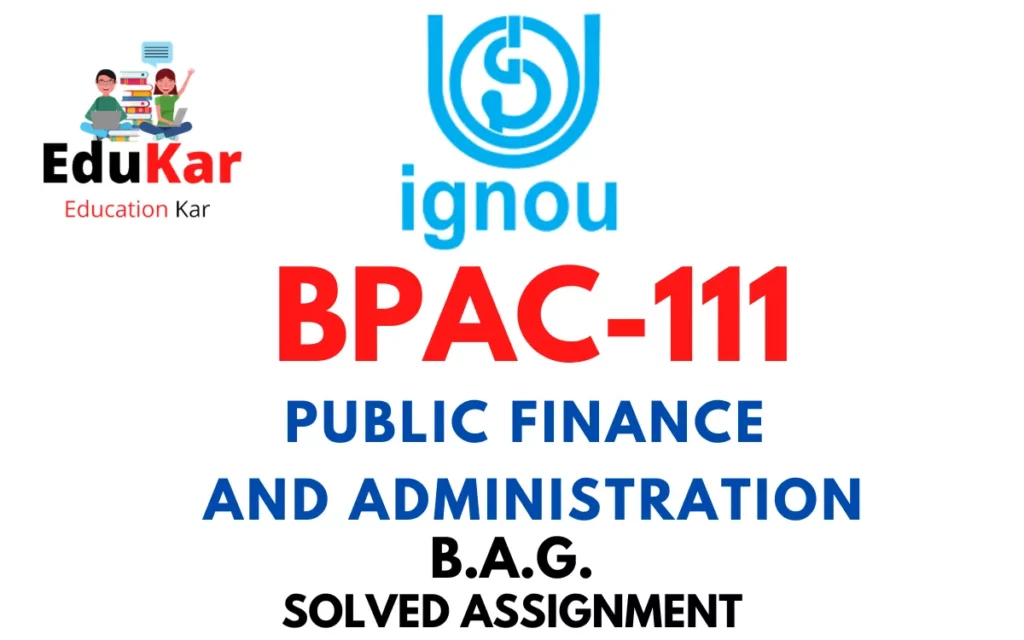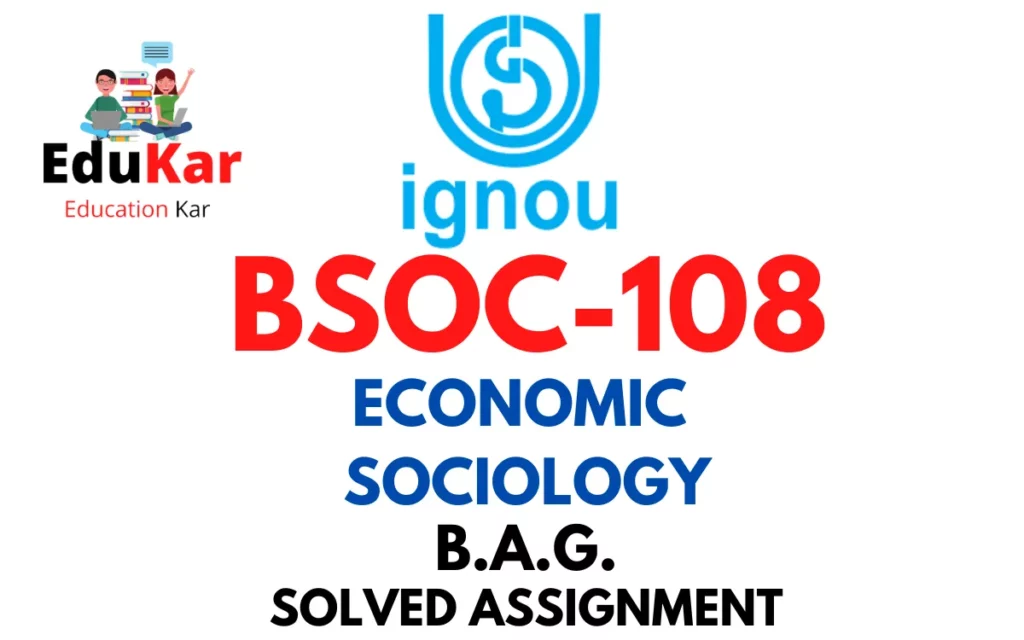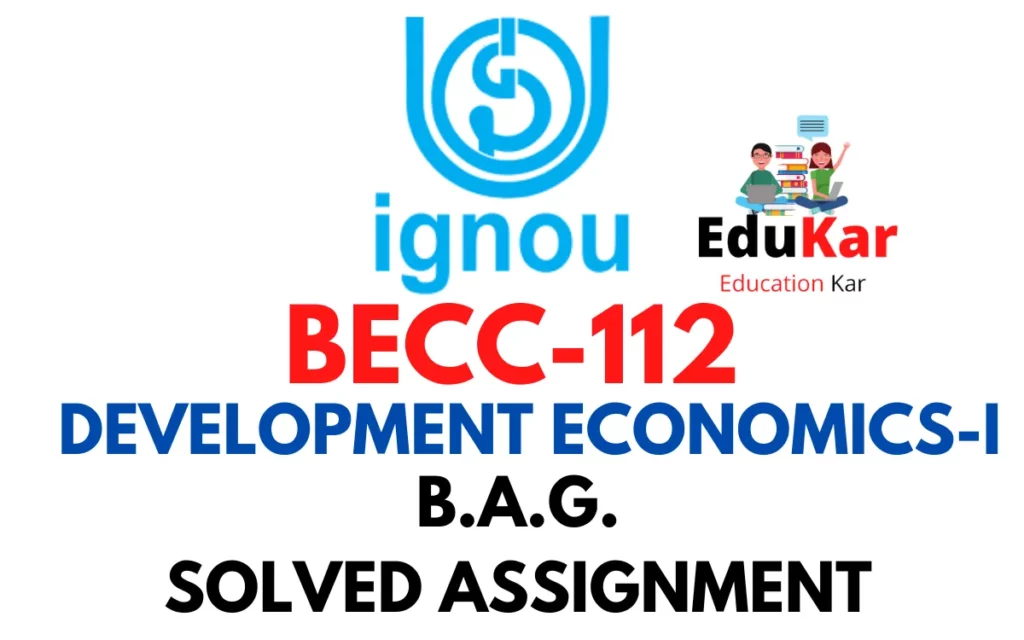Contents
- 1 A. Long Answer Questions (word limit-500 words)
- 2 1) Explain the different instruments of Monetary Policy.
- 3 2) Discuss the policy initiatives of India during the period 2015-2020 for improving the sectoral performance of the economy.
- 4 B. Medium Answer Questions (word limit-250 words)
- 5 3) Outline the two major types of fiscal policy along with its implications.
- 6 4) Indicate the importance of agricultural sector in stimulating the overall economic growth of an economy.
- 7 5) Analyse the trend in the industrial performance of India during the post-1991 phase.
- 8 C. Short Answer Questions (word limit 100 words)
- 9 6) Differentiate between:
- 10 (a) Micro & Tiny Enterprises and Small Enterprises.
- 11 (b) Repo Rate and Reverse Repo Rate.
- 12 (c) Fiscal Deficit and Revenue Deficit.
- 13 7) Write short notes on the following.
- 14 (a) Export Led Growth.
- 15 (b) Multilateralism.
- 16 (c) Organised Sector Unit

| Title | BECC-113: IGNOU BAG Solved Assignment 2022-2023 |
| University | IGNOU |
| Degree | Bachelor Degree Programme |
| Course Code | BECC-113 |
| Course Name | INDIAN ECONOMY-II |
| Programme Name | Bachelor of Arts (General) |
| Programme Code | BAG |
| Total Marks | 100 |
| Year | 2022-2023 |
| Language | English |
| Assignment Code | BECC-113/AST/TMA/2022-23 |
| Last Date for Submission of Assignment: | For June Examination: 31st April For December Examination: 30th September |

A. Long Answer Questions (word limit-500 words)
1) Explain the different instruments of Monetary Policy.
Ans: Monetary policy refers to the actions taken by a country’s central bank to regulate the supply of money and credit in the economy, in order to achieve macroeconomic goals such as price stability, low inflation, and sustainable economic growth. There are several instruments that central banks use to implement monetary policy, and they can be broadly classified into two categories: quantitative and qualitative.
Quantitative instruments are designed to influence the quantity of money in circulation, and they include:
- Open market operations: This refers to the buying and selling of government securities by the central bank in the open market. When the central bank buys government securities, it injects money into the economy, thereby increasing the money supply. Conversely, when it sells securities, it drains money from the economy, reducing the money supply.
- Reserve requirements: This refers to the amount of money that banks are required to hold in reserve with the central bank. By changing the reserve requirements, the central bank can either increase or decrease the amount of money that banks have available to lend, thereby affecting the money supply.
- Discount rate: This is the interest rate at which banks can borrow money from the central bank. By changing the discount rate, the central bank can either encourage or discourage banks from borrowing money, which can influence the amount of money in circulation.
Qualitative instruments, on the other hand, are designed to influence the allocation of credit and the behavior of financial institutions, and they include:
- Credit rationing: This refers to the practice of limiting the amount of credit that banks can extend to borrowers. By using credit rationing, the central bank can encourage banks to lend to certain sectors of the economy, such as small businesses or infrastructure projects, while discouraging lending to other sectors that may be considered risky.
- Moral suasion: This refers to the use of persuasion and communication to influence the behavior of financial institutions. The central bank can use moral suasion to encourage banks to adopt certain lending practices, or to discourage them from engaging in practices that may be considered harmful to the economy.
- Direct controls: This refers to the use of regulations and directives to control the behavior of financial institutions. For example, the central bank may set limits on the interest rates that banks can charge on loans, or it may require banks to hold a certain amount of government securities in their portfolios.
2) Discuss the policy initiatives of India during the period 2015-2020 for improving the sectoral performance of the economy.
Ans: India implemented several policy initiatives during the period 2015-2020 aimed at improving the sectoral performance of the economy. Here are some of the major policy initiatives:
- Make in India: Launched in September 2014, this initiative aimed to transform India into a global manufacturing hub by encouraging foreign and domestic companies to invest in manufacturing and infrastructure sectors. The policy included measures such as easing regulatory norms, improving infrastructure, and providing incentives for investment.
- Digital India: Launched in July 2015, this initiative aimed to transform India into a digitally empowered society and knowledge economy by leveraging technology. The policy included measures such as expanding broadband connectivity, promoting digital literacy, and digitizing government services.
- Start-up India: Launched in January 2016, this initiative aimed to promote entrepreneurship and create a supportive ecosystem for start-ups in India. The policy included measures such as simplifying regulatory norms, providing funding and mentorship support, and creating incubation centers.
- Swachh Bharat Abhiyan: Launched in October 2014, this initiative aimed to improve sanitation and cleanliness in India. The policy included measures such as building toilets, creating waste management systems, and promoting behavior change.
- Pradhan Mantri Jan Dhan Yojana: Launched in August 2014, this initiative aimed to promote financial inclusion by providing access to banking services and financial literacy. The policy included measures such as opening bank accounts for every household, providing debit cards, and creating insurance and pension schemes.
- Skill India: Launched in July 2015, this initiative aimed to provide skill development and training to the Indian workforce to make them employable and improve their productivity. The policy included measures such as creating skill development centers, providing apprenticeships, and promoting vocational education.
- Ujwal DISCOM Assurance Yojana: Launched in November 2015, this initiative aimed to improve the financial and operational performance of state electricity distribution companies. The policy included measures such as reducing transmission and distribution losses, increasing metering efficiency, and promoting renewable energy.
These policy initiatives aimed to improve the sectoral performance of the Indian economy by addressing various challenges faced by different sectors. For example, Make in India and Start-up India aimed to promote manufacturing and entrepreneurship, while Digital India aimed to leverage technology to improve the efficiency of various sectors. Similarly, Swachh Bharat Abhiyan aimed to improve sanitation and hygiene, while Skill India aimed to improve the productivity of the workforce. Overall, these policy initiatives aimed to create a conducive environment for sustainable economic growth and development in India.
B. Medium Answer Questions (word limit-250 words)
3) Outline the two major types of fiscal policy along with its implications.
Ans: Fiscal policy refers to the use of government spending and taxation to influence economic activity. There are two major types of fiscal policy: expansionary and contractionary.
Expansionary fiscal policy involves increasing government spending and/or reducing taxes in order to stimulate economic growth. The goal of this type of policy is to increase consumer and business spending, which can lead to higher employment levels and increased economic output. However, expansionary fiscal policy can also lead to inflation if it is not carefully implemented. This is because increased government spending can create excess demand in the economy, which can push up prices.
Contractionary fiscal policy, on the other hand, involves decreasing government spending and/or increasing taxes in order to slow down economic growth. The goal of this type of policy is to reduce consumer and business spending, which can help to prevent inflation and cool down an overheating economy. However, contractionary fiscal policy can also lead to higher levels of unemployment and reduced economic output. This is because decreased government spending can reduce demand in the economy, which can lead to lower business revenues and ultimately result in job losses.
The specific implications of each type of fiscal policy will depend on a variety of factors, including the current state of the economy, the specific policy measures being implemented, and the timing and duration of those measures. Overall, the goal of fiscal policy is to support a healthy and stable economy, and policymakers must carefully balance the potential benefits and drawbacks of each type of policy in order to achieve this goal.
4) Indicate the importance of agricultural sector in stimulating the overall economic growth of an economy.
Ans: The agricultural sector plays a critical role in stimulating overall economic growth in many economies around the world. Here are some of the reasons why:
- Employment: Agriculture is a major source of employment, particularly in rural areas. This means that investment in agriculture can help to create jobs and reduce poverty, which can have positive knock-on effects for the wider economy.
- Food security: A strong agricultural sector is essential for ensuring that a country’s population has access to sufficient, safe, and nutritious food. This can help to reduce malnutrition and improve public health outcomes, which can have wider economic benefits such as reduced healthcare costs and increased productivity.
- Exports: Many countries rely on agricultural exports as a major source of foreign exchange earnings. This can help to boost economic growth, create jobs, and improve the balance of trade.
- Input into other sectors: Agriculture is an important supplier of raw materials and intermediate goods to other sectors of the economy, such as food processing and manufacturing. This means that improvements in agricultural productivity and efficiency can have positive spillover effects for other sectors of the economy.
- Innovation: The agricultural sector can be a source of innovation and technological development, particularly in areas such as crop breeding, irrigation, and pest control. This can help to boost productivity and efficiency in the sector, and may also have wider applications in other parts of the economy.
Overall, the importance of the agricultural sector in stimulating overall economic growth will depend on the specific characteristics of the economy in question. However, in many cases, investing in agriculture can be a key driver of economic development and poverty reduction.
5) Analyse the trend in the industrial performance of India during the post-1991 phase.
Ans: The post-1991 phase in India is often referred to as the period of economic liberalization, privatization, and globalization, which involved significant policy changes and structural reforms in the Indian economy. The following is an analysis of the trend in the industrial performance of India during this period:
- Industrial growth: The Indian industry has seen an overall growth in the post-1991 phase. The industrial output of India has been increasing steadily since the mid-1990s, with the industrial growth rate averaging around 7% per annum. This growth is mainly attributed to the growth in manufacturing, which is the most significant sector of the industry.
- Diversification of industry: One of the key features of the post-1991 period has been the diversification of the Indian industry. There has been a shift in the industrial structure from being largely dominated by the traditional, labor-intensive industries, such as textiles and food processing, to more capital-intensive and technologically advanced industries, such as information technology, electronics, and biotechnology.
- Investment and FDI: The liberalization policies of the post-1991 phase have facilitated foreign direct investment (FDI) and domestic investment in the industry, leading to a considerable increase in capital inflows. India’s share of FDI has risen from just 0.1% of the world total in 1991 to around 2% in recent years, making it one of the fastest-growing economies in terms of FDI.
- Employment: The industrial sector has also experienced a significant increase in employment opportunities since the post-1991 phase. The share of employment in the industry has increased from 10% in 1991 to 25% in recent years. However, the rate of employment growth in the industry has been slower than the overall growth in the industry.
- Challenges: Despite the overall positive trend in the industrial performance of India during the post-1991 phase, there are still several challenges that the sector faces. Some of the significant issues include infrastructure bottlenecks, regulatory hurdles, lack of skilled labor, and the high cost of credit.
C. Short Answer Questions (word limit 100 words)
6) Differentiate between:
(a) Micro & Tiny Enterprises and Small Enterprises.
Ans: In India, the Ministry of Micro, Small and Medium Enterprises (MSMEs) classifies enterprises based on their size and investment in plant and machinery or equipment. Micro enterprises are those where the investment in plant and machinery or equipment does not exceed Rs. 1 crore, while for tiny enterprises, the investment limit is Rs. 25 lakhs. Small enterprises are those where the investment in plant and machinery or equipment is more than Rs. 25 lakhs but does not exceed Rs. 5 crores. Thus, the main difference between micro and tiny enterprises and small enterprises is the amount of investment in plant and machinery or equipment.
(b) Repo Rate and Reverse Repo Rate.
Ans: Repo rate and reverse repo rate are monetary policy tools used by the central bank of a country to control the money supply in the economy.
Repo rate is the rate at which the central bank lends money to commercial banks against government securities as collateral. When the central bank wants to increase the money supply in the economy, it lowers the repo rate, which makes it cheaper for commercial banks to borrow money from the central bank. As a result, commercial banks increase their lending to customers, which stimulates economic growth.
Reverse repo rate is the rate at which the central bank borrows money from commercial banks. When the central bank wants to decrease the money supply in the economy, it increases the reverse repo rate, which makes it more attractive for commercial banks to park their excess funds with the central bank rather than lend them out. As a result, the availability of credit in the economy decreases, which reduces inflationary pressures.
(c) Fiscal Deficit and Revenue Deficit.
Ans. Fiscal deficit and revenue deficit are both indicators of the financial health of a government, and they relate to the government’s income and expenditure.
Fiscal deficit is the difference between the total expenditure of the government and its total revenue, including non-debt capital receipts. It indicates the total amount of borrowing that the government needs to undertake to meet its expenditure needs. A higher fiscal deficit implies a higher level of government borrowing, which can have long-term implications for the economy.
Revenue deficit, on the other hand, is the difference between the government’s revenue expenditure and its revenue receipts. It reflects the amount of money that the government is borrowing to meet its day-to-day expenditure needs, which is not being used for capital expenditure or investment. A higher revenue deficit indicates that the government is spending more money on current expenses than it is earning, which can also have long-term implications for the economy.
7) Write short notes on the following.
(a) Export Led Growth.
Ans: Export-led growth is a strategy for economic development in which a country focuses on exporting its goods and services to other countries to drive economic growth. This strategy involves expanding production, encouraging investment in export-oriented industries, and pursuing policies to promote trade, such as reducing barriers to trade and opening up to foreign investment.
The theory behind export-led growth is that by producing goods and services that are in high demand in other countries, a country can achieve higher levels of economic growth than it would be possible through domestic consumption alone. This is because the export market provides access to a larger customer base, leading to higher revenues, more job opportunities, and increased productivity.
Export-led growth has been implemented by several countries, including South Korea, China, and Taiwan, with significant success. However, there are also potential downsides to this strategy, such as the risks associated with over-reliance on a single export market, the potential for a loss of domestic demand, and the negative impacts on local industries that may not be able to compete with lower-priced imports.
(b) Multilateralism.
Ans: Multilateralism is a principle and approach to international relations in which multiple countries work together to address common challenges and achieve common goals. Multilateralism involves cooperation, collaboration, and decision-making through international institutions such as the United Nations, the World Trade Organization, and other regional or global organizations.
The benefits of multilateralism are numerous. It allows countries to pool their resources, expertise, and ideas to tackle global challenges such as climate change, poverty, and conflict, which are often beyond the capacity of individual countries to address. Multilateralism also promotes dialogue and understanding among countries with different political systems, cultures, and interests, which can help to prevent conflicts and promote peace.
Furthermore, multilateralism allows for more effective regulation of international trade and finance, and can promote economic growth and development through the facilitation of global commerce. It also provides a platform for the promotion of human rights and social justice, allowing countries to work together to combat discrimination, inequality, and other forms of injustice.
However, multilateralism faces several challenges, including the lack of trust between nations, unequal power relations, and the difficulty of achieving consensus on complex and often controversial issues. Additionally, some countries may prefer to pursue their interests unilaterally, which can hinder the effectiveness of multilateral cooperation.
Despite these challenges, the principle of multilateralism remains an important pillar of international relations. As the world becomes increasingly interconnected and interdependent, it is essential for countries to work together to address common challenges and achieve common goals in a cooperative and collaborative manner.
(c) Organised Sector Unit
Ans: An organized sector unit refers to a business or industry that is formally registered with the government and operates within the legal framework of a country. These units are characterized by formal contracts, social security benefits, and adherence to labor laws and regulations. Organized sector units are typically larger, more capital-intensive, and more technologically advanced than their counterparts in the unorganized sector.
In many developing countries, the organized sector is an important source of employment and economic growth. It includes a wide range of industries, such as manufacturing, construction, transport, and services. Organized sector units are typically subject to greater government oversight and regulation than unorganized sector units. They are required to follow labor laws, minimum wage regulations, health and safety guidelines, and environmental regulations.
In the organized sector, workers generally have better working conditions, access to social security benefits such as health insurance, pension plans, and other employee benefits. They are also more likely to have formal contracts and job security, which can help to reduce the incidence of exploitation, abuse, and unsafe working conditions.
How to Download BECC-113 Solved Assignment?
You can download it from the www.edukar.in, they have a big database for all the IGNOU solved assignments.
Is the BECC-113 Solved Assignment Free?
Yes this is absolutely free to download the solved assignment from www.edukar.in
What is the last submission date for BECC-113 Solved Assignment?
For June Examination: 31st April, For December Examination: 30th October
















